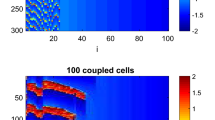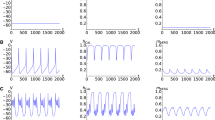Abstract
Based on bifurcation analysis, the synchronization behaviors of two identical pancreatic β-cells connected by electrical and chemical coupling are investigated, respectively. Various firing patterns are produced in coupled cells when a single cell exhibits tonic spiking or square-wave bursting individually, irrespectively of what the cells are connected by electrical or chemical coupling. On the one hand, cells can burst synchronously for both weak electrical and chemical coupling when an isolated cell exhibits tonic spiking itself. In particular, for electrically coupled cells, under the variation of the coupling strength there exist complex transition processes of synchronous firing patterns such as “fold/limit cycle” type of bursting, then anti-phase continuous spiking, followed by the “fold/torus” type of bursting, and finally in-phase tonic spiking. On the other hand, it is shown that when the individual cell exhibits square-wave bursting, suitable coupling strength can make the electrically coupled system generate “fold/Hopf” bursting via “fold/fold” hysteresis loop; whereas, the chemically coupled cells generate “fold/subHopf” bursting. Especially, chemically coupled bursters can exhibit inverse period-adding bursting sequence. Fast–slow dynamics analysis is applied to explore the generation mechanism of these bursting oscillations. The above analysis of bursting types and the transition may provide us with better insight into understanding the role of coupling in the dynamic behaviors of pancreatic β-cells.













Similar content being viewed by others
References
Arenas A, Diaz-Guilera A, Kurths J, Moreno Y, Zhou CS (2008) Synchronization in complex networks. Phys Rep 469(3):93–153
Ashcroft FM, Rorsman P (1989) Electrophysiology of the pancreatic β-cell. Prog Biophys Mol Biol 54:87–143
Bergsten P (2000) Pathophysiology of impaired pulsatile in insulin release. Diabetes Metab Res Rev 16:179–191
Calabrese A, Bosco D, Soria B, Wollheim CB, Herrera PL, Meda P (2000) Junctional communication of pancreatic β-cells contributes to the control of insulin secretion and glucose tolerance. J Clin Invest 106:235–243
Cunningham BA, Deeney JT, Bliss CR, Corkey BE, Tornheim K (1996) Glucose-induced oscillatory insulin secretion in perifused rat pancreatic and clonal β-cells (HIT). Am J Physiol 271:702–710
De Vries G, Sherman A (1998) Diffusively coupled bursters: effects of cell heterogeneity. Bull Math Biol 60:1167–1199
De Vries G, Sherman A (2000) Channel sharing in pancreatic β-cells revisited: enhancement of emergent bursting by noise. J Theor Biol 207:513–530
Dean PM, Mathews EK (1970) Glucose induced-electrical activity in pancreatic islet cells. J Physiol 210(2):255–264
Eddlestone GT, Goncalves A, Bangham JA, Rojas E (1984) Electrical coupling between cells in islets of Langerhans from mouse. J Memb Biol 77:1–14
Gomez-Gardenes J, Moreno Y, Arenas A (2007) Paths to synchronization on complex networks. Phys Rev Lett 98:034101
Izhikevich EM (2000) Neural excitability, spiking and bursting. Int J Bifurcat Chaos 10:1171–1266
Kennedy RT, Kauri LM, Dahlgren GM, Jung SK (2002) Metabolic oscillations in β-cells. Diabetes 51(Suppl 1):52–61
Krasimira TA, Zimliki CharlesL, Bertram R, Sherman A (2006) Diffusion of calcium and metabolites in pancreatic islets: killing oscillations with a pitchfork. J Biophys 90:3434–3446
Marek M, Stuchl I (1975) Synchronization in two interacting oscillatory systems. Biophys Chem 3(3):241–248
Meissner HP (1976) Electrophysiological evidence for coupling between β-cells of pancreatic islets. Nature 262:502–504
Orci L, Malaisse-Lagae F, Amherdt M, Ravazzola M, Weisswange A, Dobbs R, Perrelet A, Unger R (1975) Cell contacts in human islets of Langerhans. J Clin Endocrinol Metab 41:841–844
Perc M, Marhl M (2003) Different types of bursting calcium oscillations in non-excitable cells. Chaos Solitons Fractals 18:759–773
Perc M, Marhl M (2004a) Local dissipation and coupling properties of cellular oscillators: a case study on calcium oscillations. Bioelectrochemistry 62:1–10
Perc M, Marhl M (2004b) Synchronization of regular and chaotic oscillations: the role of local divergence and the slow passage effect. Int J Bifurcat Chaos 14:2735–2751
Ravier MA, Gilon P, Henquine JC (1999) Oscillations of insulin secretion can be triggered by imposed oscillations of cytoplasmic Ca2+ or metabolism in normal mouse islets. Diabetes 48(12):2374–2382
Rinzel J (1987) A formal classification of bursting mechanisms in excitable systems. In: Teramot E, Yamaguti M (eds) Mathematical topics in population biology, morphogenesis and neurosciences, vol 71. Lecture Notes in Biomathematics. Springer, Berlin, pp 267–281
Rorsman P, Berggren PO, Bokvist K, Ericson H, Mohler H, Ostenson CG, Smith PA (1989) Glucose-inhibition of glucagon secretion involves activation of GABAA-receptor chloride channels. Nature 341:233–236
Rubin J, Terman D (2002) Geometric singular perturbation analysis of neuronal dynamics. In: Fiedler B (ed) Handbook of dynamical systems, vol 2. Elsevier, pp 93–146
Salehi A, Qader SS, Grapengiesser E, Hellman B (2005) Inhibition of purinoceptors amplifies glucose-stimulated insulin release with removal of its pulsatility. Diabetes 54:2126–2131
Sherman A (1994) Anti-phase, asymmetric and aperiodic oscillations in excitable cells—I. Coupled bursters. Bull Math Biol 56:811–835
Sherman A, Rinzel J (1991) Model for synchronization of pancreatic beta-cells by gap junctions. J Biophys 59:547–559
Sherman A, Rinzel J (1992) Rhythmogenic effects of weak electrotonic coupling in neuronal models. Proc Natl Acad Sci USA 89:2471–2474
Sherman A, Rinzel J, Keizer J (1988) Emergence of organized bursting in clusters of pancreatic β-cells by channel sharing. J Biophys 54:411–425
Sun XJ, Lei JZ, Perc M, Kurths J, Chen GR (2011) Burst synchronization transitions in a neuronal network of subnetworks. Chaos 21:016110
Terman D (1992) The transition from bursting to continuous spiking in excitable models. J Nonlinear Sci 2:135–182
Valdeolmillos M, Gomis A, Sanchez-Andres JV (1996) In vivo synchronous membrane potential oscillations in mouse pancreatic β-cells: lack of co-ordination between islets. J Physiol 493:9–18
Volman V, Perc M, Bazhenov M (2011) Gap junctions and epileptic seizures—two sides of the same coin? PLoS One 6:e20572
Wang R, Jiao X (2006) A stochastic nonlinear evolution model and neural coding on neuronal population possessing variable coupling intensity in spontaneous behavior. Neurocomputing 69(7–9):778–785
Wang R, Zhang Z (2003) Nonlinear stochastic models of neurons activities. Neurocomputing 51:401–411
Wang QY, Chen GR, Perc M (2011) Synchronous bursts on scale-free neuronal networks with attractive and repulsive coupling. PLoS One 6(1):e15851
Zhang Q, Galvanovskis J, Abdulkader F, Partridge CJ, Göpel S, Eliasson L, Rorsman P (2008) Cell coupling in mouse pancreatic β-cells measured in intact islets of Langerhans. Phil Trans R Soc A 366:3503–3523
Zhang X, Wang R, Zhang Z, Qu J, Cao J, Jiao X (2010) Dynamic phase synchronization characteristics of variable high-order coupled neuronal oscillator population. Neurocomputing 73:2665–2670
Acknowledgments
This work was supported by the National Natural Science Foundation of China (No. 11172017).
Author information
Authors and Affiliations
Corresponding author
Appendix
Appendix
a Time series of the single model with g s = 2. b Bifurcation diagram of the fast subsystem of [Eqs. (8), (9)]. H refers to the supHopf bifurcation, F1 and F2 refer to the fold bifurcations, HC refers to the homoclinic bifurcation. The C shaped curve represents the maximum and minimum values of periodic solutions originated from H. The phase plot of the whole system is also superposed on the (v, s) plane. The red line is the s-nullcline. (Color figure online)
a Time series of the single model with g s = 4. b Bifurcation diagram of the fast subsystem. The description of the lines and points is the same as that in Fig. 14b
The model for a single pancreatic β-cell is described by the following equations:
Three variables in this system are: the membrane potential (v), the delayed rectifier activation (n), and a very slow variable s which has been postulated to be the intracellular Ca2+ (Sherman et al. 1988). The s equation is a Ca2+-balance equation.
Equation (7) is the current balance equation that determines the membrane potential v and is composed of four ionic currents, which are defined by
with the constant conductance g Ca , g K , g s and g K(ATP) and the reversal potentials v Ca , v K for Ca2+ and K+ ions, respectively. I Ca is assumed to respond instantaneously to a change in membrane potential with the steady state function \( m_{\infty } (v) \), while the dynamics for I K is governed by the gating variable n via Eq. (2), where τ is the activation time constant for the delayed rectifier K+ channel, and \( n_{\infty } (v) \) is the equilibrium function for the activation variable n. In the expression of I K(ATP), p is the fraction of the open K(ATP) channels. The dynamics for I s is similar to that of I K . But comparing with τ, the time constant τ s becomes much bigger.
The equilibrium functions \( m_{\infty } (v) \), \( n_{\infty } (v) \) and \( s_{\infty } (v) \) have the general expression given by \( x_{\infty } (v) \) as follows:
Since τ s >> τ, s responds on a much slower time scale than v and n. Thus Eqs. (7)–(9) construct a system with both slow and fast scales. The fast subsystem is composed of Eqs. (7) and (8), in which the slow variable s is considered as the bifurcation parameter. The trajectory of the whole system is then superimposed on the bifurcation diagram of the fast subsystem to explain the dynamical behavior of the model; this is the fast–slow dynamics analysis (Rinzel 1987).
All the parameters are listed in Table 1. Depending on the value of the parameter g s , the system either undergoes a spiking solution or generates bursting oscillations. Both of which can be explained by using fast–slow dynamics analysis. The details of the two typical cases are explained as follows.
When g s = 2, the single cell gives continuous spiking (see Fig. 14a). The bifurcation diagram of the fast subsystem with respect to the slow variable s is plotted in Fig. 14b. The equilibrium points form a Z shaped curve in (v, s) plane. The Z shaped curve is made up of the upper, middle and the lower branch. With the increase of s, the stable foci on the upper branch become unstable via a supHopf bifurcation H at s = −0.235. A branch of stable limit cycle oscillations emerges from the H point, and it terminates at homoclinic bifurcation HC. The middle and lower branches are composed of saddles and stable nodes, respectively. The s-nullcline is also superimposed onto the bifurcation diagram. The dynamics of the full system can be understood by using the Z shaped curve and the s-nullcline together. It is seen that the s-nullcline intersects the periodic branch and the intersection sufficiently deeps into the periodic branch, so that the system produces continuous spiking (Terman 1992).
When g s = 4, the single cell exhibits a typical bursting oscillation (see Fig. 15a). Fast–slow dynamics analysis is illustrated in Fig. 15b. It is noticed that g s is not involved in the slow subsystem. Hence, it has no effect on the s-nullcline. Compared with Fig. 14b, it is seen that the s-nullcline still intersects with the periodic branch, and at this time the intersection is near the end of the periodic branch. If the variable s varied very slowly, this would result in continuous spiking. However, s does not vary such slow actually in this case so that the bursting can be produced (Terman 1992). Moreover, for values of s between the left knee of the Z shaped curve and the homoclinic bifurcation, there is bistablility between the stable node state on the lower branch, which corresponds to the silent phase of bursting, and the stable limit cycle oscillation corresponding to the active phase of bursting. The silent phase disappears via the fold bifurcation F1, and the active phase ends with the homoclinic bifurcation HC. Since this type of bursting depends on passing through both fold and homoclinic bifurcations, it is called as “fold/homoclinic” bursting (Perc and Marhl 2003). It is also known as “square-wave” bursting, due to the fact that the active phase spikes rise from a plateau (Rinzel 1987).
Rights and permissions
About this article
Cite this article
Meng, P., Wang, Q. & Lu, Q. Bursting synchronization dynamics of pancreatic β-cells with electrical and chemical coupling. Cogn Neurodyn 7, 197–212 (2013). https://doi.org/10.1007/s11571-012-9226-9
Received:
Revised:
Accepted:
Published:
Issue Date:
DOI: https://doi.org/10.1007/s11571-012-9226-9






